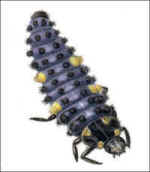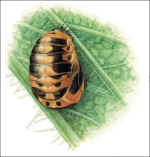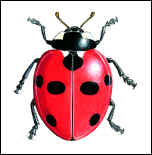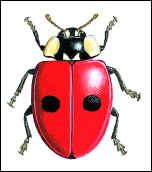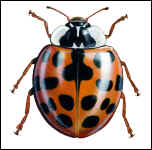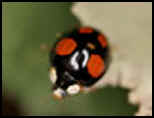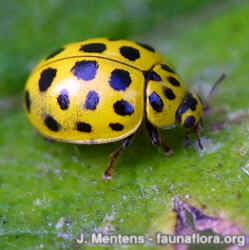
22-spot Ladybird
LADYBIRD DOSSIER
There
are 26 recognisable ladybirds in the UK, mostly distributed in the
southern half, and mostly named after the number of spots on their
shiny backs. They are members of the Coleoptera beetle family and
characterised by hard forewings and biting mouthparts. They undertake
a four-stage ecology, from egg to larva to pupa then adult. Adult
females can lay between several hundred and 4000 eggs during her short
life, the period from egg to adult being typically four to five weeks.
The larva look quite different to the adult stage. The creatures
over-winter as dormant adults, usually indoors somewhere, becoming
active again in early spring.
The species most probably found in our Cookham gardens is the 7-spot, which can survive outdoors in winter, and occupies low herbage in many settings. We also have lots of the 2-spot variety which can be found anywhere there are aphids to feed on. Good numbers of the 22-spot variety can be found and numbers of Pine Ladybird have been seen around the outskirts of Widbrook Common.
Of course, much public attention has been paid to the notorious Harlequin Ladybird, which has been found in the UK since 2004, brought in on the many imported plants from mainland Europe. This voracious beetle is not beyond eating other ladybird species if aphids are in short supply (I’ve seen one completely consume a 2-spot in just a couple of minutes, leaving not a trace of its fate!). It is bigger, fiercer and more resilient than the rest of the family and its numbers have exploded from a few hundred 3 years ago to groups of thousands of insects being found in 2007. And they have reached Cookham, with examples known from Broomhill, The Lea and Alleyns Lane.
But as to the general distribution of the insects mentioned above around the Cookhams, and the many other species not mentioned here, we are unsure what is out there. Why not help us by carrying out ‘Ladybird Forays’ this summer, in the garden and surrounding countryside, sending in your findings, or photographs if you are unsure which one you have found.
An excellent web site for further research is that of the UK Ladybird Survey (www.ladybird-survey.org) “
|
Typical Larva |
|
|
|
Late Instar Lava - as it grows, a larva sheds its skin four times (ie has four instars). The larval stage lasts about three or four weeks, depending on food availability and weather. |
||
|
Typical Pupa |
|
|
|
Pupal Stage - the lava pupates for about a week. The pupa is attached to a leaf or other substrate. It remains still but can flick one end up to defend itself. |
||
|
7 Spot Ladybird |
|
|
|
The Seven-spot Ladybird is a member of the beetle family Coccinellidea, in the Order Coleoptera, and is our most common ladybird. It is one of 25 species found in this country. |
||
|
2 Spot Ladybird |
|
|
|
A small and common ladybird but with a number of colour varieties. Some are black with red spots and some have merged or multiple spots! The black versions are most common in the north where it helps the insect to absorb heat from the sun. |
||
|
Harlequin Ladybird |
|
|
|
An extremely voracious predator, the Harlequin ladybird easily out-competes native ladybirds for its preferred food of green fly and scale insects. It will readily prey on native ladybirds if food is scarce. |
||
|
Harlequin Ladybird |
|
|
|
This is another form of the Harlequin ladybird. |
||
|
||
